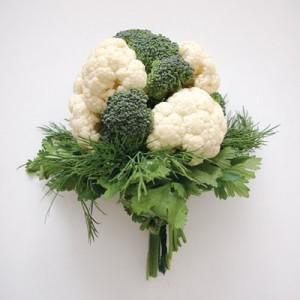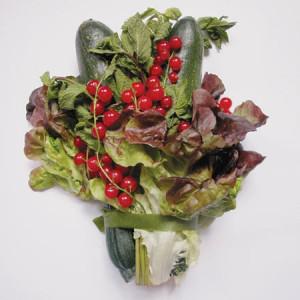What we eat has a serious ecological impact. With food production accounting for almost 20 percent of our fossil-fuel use in the United States, we have to change our approach to mealtime if we want to reverse climate change. By going on an “earth-friendly” diet, you’ll focus less on cutting calories and carbs and more on cutting carbon.
- Eat Locally, Organically and Seasonally: Buy local and organic is the best first step towards an earth-friendly diet.
 Buying local helps mitigate the carbon costs of packaging and shipping. You’ll also get fresher goods as nutrients get lost as soon as fruits and vegetables are harvested. Also try to stick to what’s in season in your area, as opposed to what you see on display in your local grocery store. These ingredients travel shorter distances and often taste better. To find out what grows in your region and when, visit Local Harvest.
Buying local helps mitigate the carbon costs of packaging and shipping. You’ll also get fresher goods as nutrients get lost as soon as fruits and vegetables are harvested. Also try to stick to what’s in season in your area, as opposed to what you see on display in your local grocery store. These ingredients travel shorter distances and often taste better. To find out what grows in your region and when, visit Local Harvest. - Grow Your Own: You don’t have to grow an entire vegetable garden to reap benefits. Start small with staples such as basil and rosemary. Or other easy items such as tomatoes, beans and greens.
- Chose Your Drinks Wisely: Not only do you need to pay attention to the foods you eat, but those same pesticides and fertilizers used to produce food also go into making your juice, milk, coffee, tea, wine and other beverages. Coffee often grows on land where rain forests once thrived and by destroying rain forests, we’re not only increasing the amount of greenhouse gases in the atmosphere, but also potentially sending half of all bird species in those areas into extinction. Instead, opt for organic and shade-grown coffee (look for the Rainforest Alliance or Bird Friendly seal). Also look for organic wine, beer and vodka.
- Be Takeout Savvy: Even the greenest of us greenies order takeout on occasion. The next time you do, kindly decline paper napkins, plastic utensils, condiment packets, chopsticks and straws (try reusable glass straws by a company such as Glass Dharma instead). Take it one step further and ask if you can bring your own container and have them fill it for you.
- Ask for Sustainable Seafood: With some species now being fished to near-extinction, choosing seafood that’s been caught responsibly offers yet another way to minimize your environmental impact. Choose seafood that reproduces in great numbers, such as Dungeness crab in season and wild Alaskan salmon (both my personal favorites). Seafood Watch (www.seafoodwatch.org) provides a downloadable, wallet-sized card that lists sustainable picks. Blue Ocean Institute offers what it calls Fish-Phone. Text 30644 with the message FISH and the name of the fish; you’ll get a text back with an ecoassessment and better alternatives.
 Eat Whole Foods: Nearly 30 percent of the energy the food industry employs goes into taking raw ingredients and turning them into the products we find on grocery store shelves. To maintain freshness, these ingredients have to undergo heating, cooling, and dehydration methods – all of which require tremendous amounts of energy. Eliminating all processed foods cold cut your food-related carbon footprint by almost a third. By sticking with whole vegetables, grains, and other raw ingredients, you not only make a positive impact, you add healthier foods to your diet.
Eat Whole Foods: Nearly 30 percent of the energy the food industry employs goes into taking raw ingredients and turning them into the products we find on grocery store shelves. To maintain freshness, these ingredients have to undergo heating, cooling, and dehydration methods – all of which require tremendous amounts of energy. Eliminating all processed foods cold cut your food-related carbon footprint by almost a third. By sticking with whole vegetables, grains, and other raw ingredients, you not only make a positive impact, you add healthier foods to your diet.- Say No to Bottled Water: Americans go through an estimated 70 million-plus water bottles a day, and only 14 percent of them gets recycled. Not only do they take up space in our landfills; manufacturing, transporting, and disposing of them consumes quantities of oil. The manufacturing of plastic bottles actually requires twice the water that the bottles will ultimately contain. Use a stainless-steel or aluminum coated bottle instead of plastic and drink tap water. If you’re concerned about safety, have your water tested at a certified lab (visit the EPA to find a location near you).
- Eat Less Meat: A cow has to eat eight pounds of corn and soy grain to yield one pound of meat, and growing all that grain requires artificial fertilizers and pesticides. The manufacturing of these agricultural chemicals accounts for roughly 40 percent of food-production energy. Transporting feed to livestock operations burns even more fuel. Plus the methane gas cows emit is 21 times more potent a greenhouse gas than carbon dioxide. If you want to occasionally include meat as a meal, opt for a grass and legume based diet instead.
- Eat Less of Everything: American’s portion sizes continue to grow which takes a toll on the environment through production, packaging and transportation. So cutting down, by preparing and ordering less, not just tossing out what’s on your plate, automatically reduces your carbon footprint, as well as your caloric intake.
{image credit: Dezeen}
 Buying local helps mitigate the carbon costs of packaging and shipping. You’ll also get fresher goods as nutrients get lost as soon as fruits and vegetables are harvested. Also try to stick to what’s in season in your area, as opposed to what you see on display in your local grocery store. These ingredients travel shorter distances and often taste better. To find out what grows in your region and when, visit
Buying local helps mitigate the carbon costs of packaging and shipping. You’ll also get fresher goods as nutrients get lost as soon as fruits and vegetables are harvested. Also try to stick to what’s in season in your area, as opposed to what you see on display in your local grocery store. These ingredients travel shorter distances and often taste better. To find out what grows in your region and when, visit  Eat Whole Foods: Nearly 30 percent of the energy the food industry employs goes into taking raw ingredients and turning them into the products we find on grocery store shelves. To maintain freshness, these ingredients have to undergo heating, cooling, and dehydration methods – all of which require tremendous amounts of energy. Eliminating all processed foods cold cut your food-related carbon footprint by almost a third. By sticking with whole vegetables, grains, and other raw ingredients, you not only make a positive impact, you add healthier foods to your diet.
Eat Whole Foods: Nearly 30 percent of the energy the food industry employs goes into taking raw ingredients and turning them into the products we find on grocery store shelves. To maintain freshness, these ingredients have to undergo heating, cooling, and dehydration methods – all of which require tremendous amounts of energy. Eliminating all processed foods cold cut your food-related carbon footprint by almost a third. By sticking with whole vegetables, grains, and other raw ingredients, you not only make a positive impact, you add healthier foods to your diet.
